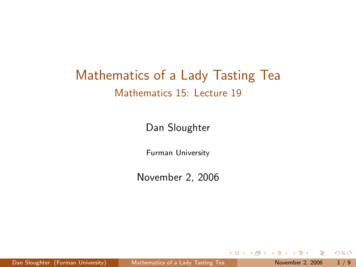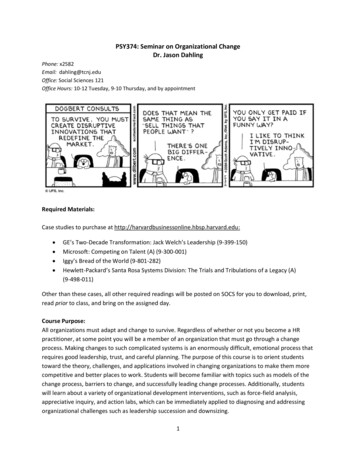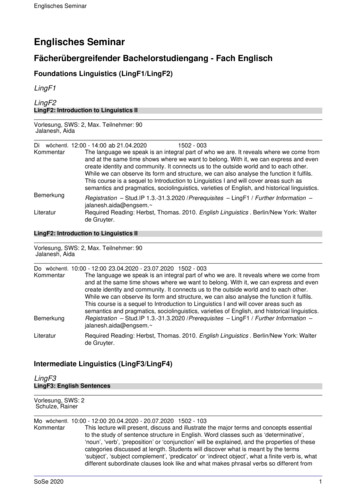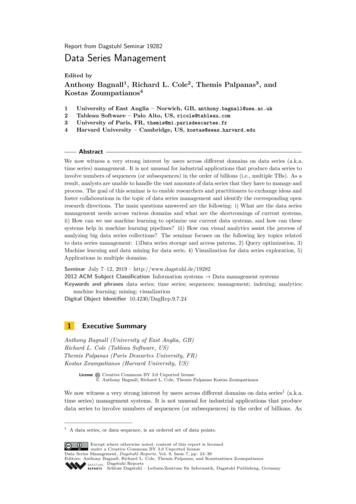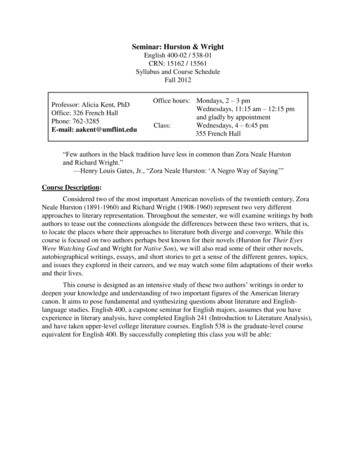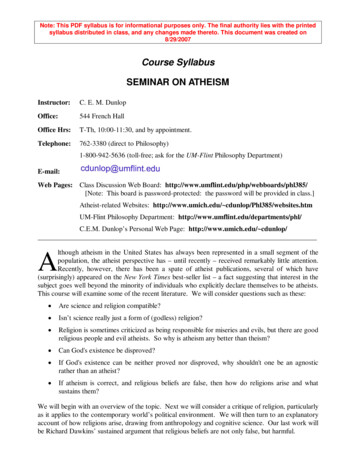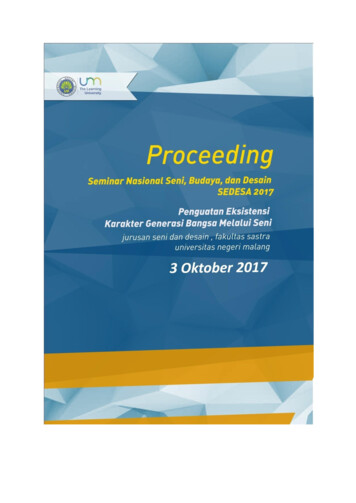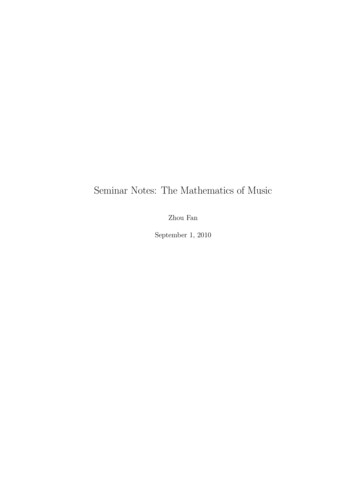
Transcription
Seminar Notes: The Mathematics of MusicZhou FanSeptember 1, 2010
2
ContentsPrefaceiii1 Understanding Musical Sound1.1 Sound, the human ear, and the sinusoidal wave1.1.1 Sound waves and musical notation . . .1.1.2 The human ear and the sinusoidal wave1.2 Timbre and resonance harmonics . . . . . . . .1.3 Fourier series and frequency analysis . . . . . .1.4 Further topics . . . . . . . . . . . . . . . . . . .1.4.1 Percussion instruments . . . . . . . . . .1.4.2 Psychoacoustic phenomena . . . . . . .1112358882 Chords, Scales, and the Fundamentals of Western Music2.1 Consonance and dissonance . . . . . . . . . . . . . . . . . . . .2.2 Scales and temperament . . . . . . . . . . . . . . . . . . . . . .2.2.1 Continued fractions and the twelve-tone scale . . . . . .2.2.2 Just intonation, Euclidean lattices, and the fundamental2.2.3 Meantone, irregular, and equal temperament . . . . . .2.3 The Javanese gamelan . . . . . . . . . . . . . . . . . . . . . . . . . . . . . . . . . . .domain. . . . . . . . .9910101315173 Musical Structure and Theory3.1 Musical symmetries and transformations . . . . . . . . .3.1.1 Groups, generators, and relations . . . . . . . . .3.1.2 Intervallic transformations . . . . . . . . . . . . .3.1.3 Transformations between major and minor triads3.1.4 Transformations of motifs and melodic passages .3.1.5 Symmetries in Debussy’s Feux d’artifice . . . . .3.2 The geometry of chords . . . . . . . . . . . . . . . . . .3.2.1 Tori of ordered chords . . . . . . . . . . . . . . .3.2.2 Orbifolds of unordered chords . . . . . . . . . . .3.2.3 Chromatically descending chord progressions . .1919192121232426262830Bibliographic Notes.33i
iiCONTENTS
PrefaceThese notes were created as a set of lecture notes for a three-day seminar on the mathematics of music,intended to introduce topics in this area to the interested reader without assuming strong prerequisitesin mathematics or music theory. They are not intended to be a comprehensive and technically rigorousexposition, and an attempt is made to introduce the concepts in an elementary way and to avoid technicaldetails when possible and appropriate. Much has been written on the connections between mathematics andmusic; this summary draws on a number of such sources, referenced to in the bibliographic notes.iii
ivCONTENTS
Lecture 1Understanding Musical Sound1.11.1.1Sound, the human ear, and the sinusoidal waveSound waves and musical notationMusic is organized sound, and it is from this standpoint that we begin our study. In the world of Westernmusic, notation has been developed to describe music in a very precise way. Consider, for instance, thefollowing lines of music:A musician who understands this notation would recognize this as the melody of “Twinkle, Twinkle LittleStar” (in the key of A major), and the symbols above encode, to great precision, various aspects of thesounds that make up this melody.Sound travels through air, a gaseous medium of molecules that are constantly in motion and exertingforces against each other. These forces create air pressure—when a large quantity of air molecules arecompressed in a small space, air pressure is high, and when air molecules are spread out at a great distancefrom one another, air pressure is low. Physically, sound is a wave of alternating high and low air pressurethat travels through time and space.To visualize a sound wave, let us consider a chronological sequence of pictures of the compression of airmolecules for a sound wave moving in the rightward direction:1
2LECTURE 1. UNDERSTANDING MUSICAL SOUNDOne should note that each individual air molecule moves only a very small distance and does not travelfar in the rightward direction, but rather that a rippling effect causes the wave to propagate rightwards.Accompanying these pictures are graphs of the air pressure at each point in space, where we shift our unitsso that the horizontal axis indicates normal atmospheric air pressure without the perturbation of sound.The shape of the functions in these graphs is called the waveform. We have drawn the wave to be periodic,meaning that it is a repetition of the same pattern across space, and indeed, a musical pitch corresponds toa periodic sound wave. The distance in space between two repetitions of the pattern is called the wavelengthof the wave or the period of the waveform. If we focus on how the wave moves through a particular point inspace, the number of repetitions of the pattern that move through that point in a single second is called thefrequency of the wave, measured in Hertz (Hz). For waves moving at the same speed, a longer wavelengthimplies a longer time for a single repetition of the pattern to move across any given point, and hence itimplies a lower frequency. Indeed, we have the relationship frequency wavelength speed of wave. Forthis particular waveform, known as the sinusoidal wave, there is a clear maximum and minimum amount ofair pressure achieved by the wave, and the difference between this and normal atmospheric pressure is calledthe amplitude of the wave.Returning to our musical example of “Twinkle, Twinkle Little Star”, we may translate the musicalnotation into statements about the physical waves that make up the sound. The first and last notes of theexample are “A above middle C”, which refers to the pitch of the note, a musical term for the frequency ofthe sound wave. This A above middle C has a frequency of 440Hz, and it is common to see the marking“A440” on digital tuners to represent this pitch. Every musical pitch corresponds to a particular frequency—for instance, the third note of E in the musical example is a frequency of 660Hz—with higher pitchescorresponding to higher frequencies and lower pitches corresponding to lower frequencies. The marking mpis a dynamic marking to indicate the volume of the sound, which corresponds to the amplitude of the soundwave. Finally, the stems and heads of the notes indicate the duration of each note, which is the amount oftime a particular sound wave is present before it changes to the next wave.1.1.2The human ear and the sinusoidal waveHow does the ear perceive sound and distinguish pitch? A picture of the ear is shown below.The outer ear, composed of the pinna, concha, and auditory canal, is responsible for amplifying sound andplays an important role in our ability to perceive the location of a sound source. Sound waves passing throughthe auditory canal create oscillations of the tympanic membrane that separates the outer and middle ear.This membrane is attached to three bones known as the ossicles, which in turn are attached to a liquid-filledtube called the cochlea in the inner ear. The ossicles transfer the oscillations of the tympanic membrane towaves in the liquid of the cochlea, and it is the cochlea that plays the main role in pitch perception.
1.2. TIMBRE AND RESONANCE HARMONICS3The above image shows a picture of a cross-section of the uncoiled cochlea. Liquid known as perilymphis contained in the regions shaded gray, and waves in this liquid induce oscillations of the basilar membrane.The basilar membrane is thin near the base of the cochlea and thick near the apex of the cochlea, andhigh frequency waves induce oscillations of the thin portion of the basilar membrane while low frequencywaves induce oscillations of the thick portion. Some graphs of the magnitude of oscillation along the basilarmembrane for different frequencies of sound are shown below:Signals from these oscillations are conveyed by auditory nerves to the brain, and the brain is able to distinguish pitch based on which region of the basilar membrane is oscillating.In the previous section, we drew a sinusoidal wave as an example of a sound wave, and we definedfrequency, wavelength, and amplitude based on this picture. The sinusoidal wave is the waveform given bythe function f (x) A sin(νx θ). The amplitude and frequency are captured in the parameters A and νrespectively, and θ corresponds to the phase of the wave, which changes over time to generate wave motion.The sinusoidal wave corresponds to the idea of a “pure” pitch as perceived by the ear and brain, and thereason lies in the physics behind the oscillation of the basilar membrane. (To a first order approximation,we may consider each point of the basilar membrane as an ideal spring. The physical equation governingthe displacement x of an ideal spring is given by F kx, where F is the force of the spring and k is thespring constant. The value of this spring constant k is higher at thicker points of the membrane and lowerat thinner points, and it determines the resonant frequency of oscillation at that point. A pure sinusoidalwave in the perilymph inside the cochlea provides a sinusoidal driving force that induces strong oscillationsat points of the basilar membrane with resonant frequency close to the frequency of this driving force, andthe strength of the oscillation is weaker as the resonant frequency is farther from the frequency of the drivingforce. This creates the graphs of oscillation magnitude displayed above, which the brain perceives as purepitches [3].)1.2Timbre and resonance harmonicsWe have attributed the pitch and volume of a musical sound to the frequency and amplitude of the soundwave. This does not, however, explain everything that we hear. Suppose that a violin and a flute play thesame pitch at the same volume level, or that an opera singer sings the same note on an “oo” and an “ee”vowel. It is easy to hear the differences between these sounds, but how are they manifested in the physicalsound waves?The answer lies in that, even though our brain perceives the sinusoidal wave as a pure musical pitch,most musical sounds that we hear are not pure pitches. Graphs of the waveforms for a violin, trumpet, andclarinet all playing the note A at 440Hz are shown below:
4LECTURE 1. UNDERSTANDING MUSICAL SOUNDWe observe that each waveform is periodic with the same period, but the shapes of the waveforms aredifferent, and none of them are sinusoidal. Indeed, each wave corresponds to a pure sinusoidal wave offrequency 440Hz, with various waves of higher frequency added to it. (In vocal singing, one can manipulateand change the strengths of these higher frequency sounds by shaping the mouth and throat, a techniquethat is used in Mongolian and Tibetan overtone singing to allow a single person to sing a melody on top ofa bass drone.) Let us, in this section, explore the causes of these superimposed frequencies from a physicalperspective for the string and wind instruments, and defer a more mathematical treatment to the subsequentsection.An important group of instruments create sound using a vibrating string. These include the violin, viola,cello, and stringed bass of the Western orchestra, the versatile piano and guitar, as well as a number oftraditional Chinese instruments including the zheng, qin, pipa, and erhu. In each of these instruments, thestring is stretched taut between two fixed ends, and the middle of the string is allowed to vibrate. Thisallows the string to produce certain patterns of standing waves known as modes.Letting L be the length of the string, the first mode of oscillation corresponds to a wavelength of twice thislength, or 2L. The nth mode corresponds to a wavelength of 2Ln . Translated into frequencies, this impliesthat if the frequency corresponding to the first mode of oscillation is f1 , then the frequency of the nth modeis nf1 . When a string vibrates to produce a sound, the standing wave of the string is a superposition of anynumber of these modes, creating a sound wave that is a superposition of pure sinusoidal waves of varyingfrequencies.A similar treatment can be applied to wind instruments. These include instruments of the woodwind family, such as flutes, clarinets, oboes, saxophones, and bassoons, as well as the brass family, such as trumpets,horns, trombones, and tubas. The model of the wind instrument is also a crude but useful approximationfor the vocal tract of the human voice. Sound in these instruments is shaped by the reverberation of sound
1.3. FOURIER SERIES AND FREQUENCY ANALYSIS5waves within a tube, which we will model as a cylinder with open or closed ends. Again, the tube allows formodes of oscillation corresponding to standing sound waves inside the tube of varying frequencies. An openend of the tube must correspond to a point of zero pressure difference from normal air pressure, similar tohow a fixed end of a string cannot be displaced. If the tube has a closed end, the endpoint of the tube mustbe a point of maximal pressure difference from normal air pressure. (This is due to the condition that thedisplacement of the air molecules at the closed end must be fixed at zero and to a relationship between thepressure and displacement.) Hence, the modes of oscillation for tubes with two open ends, such as the flute,or tubes with one closed end, such as the clarinet, are those shown below:In the case of two open ends, the wavelength of the first mode of oscillation is twice the length of the tube,and the frequency of the nth mode is n times the frequency of the first mode. In the case of one closed end,the wavelength of the first mode of oscillation is four times the length of the tube, and the frequency of thenth mode is 2n 1 times the frequency of the first mode.The frequency of the first mode of oscillation for a string or tube is known as its fundamental frequency,o
guish pitch based on which region of the basilar membrane is oscillating. In the previous section, we drew a sinusoidal wave as an example of a sound wave, and we de ned frequency, wavelength, and amplitude based on this picture. The sinusoidal wave is the waveform given by the function f(x) Asin( x ). The amplitude and frequency are captured in the parameters Aand respectively, and .


